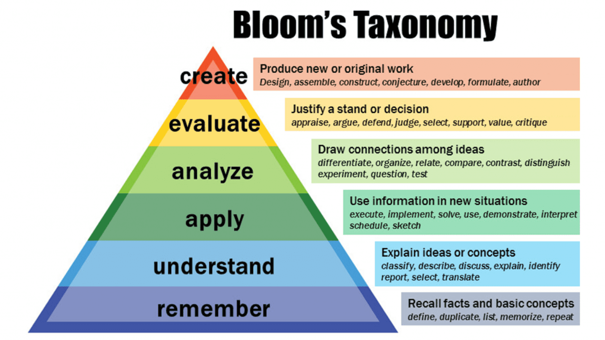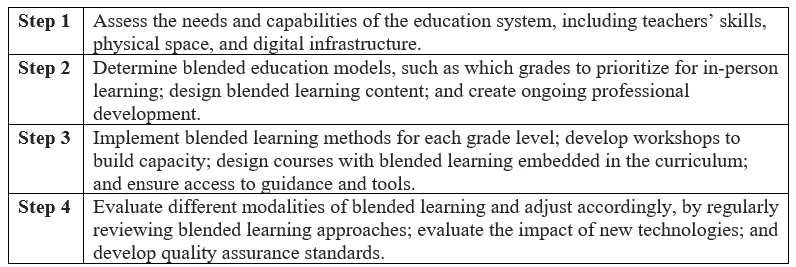 Blended learning enables new levels of flexibility, engagement, personalization, and resilience. Copyright: Ministry of Education, Saudi Arabia
Blended learning enables new levels of flexibility, engagement, personalization, and resilience. Copyright: Ministry of Education, Saudi Arabia
The COVID-19 pandemic has led school systems worldwide to experiment with various forms of blended learning—combining in-person and online instruction. These experiences have provided valuable insights into the benefits and challenges of different learning modalities.
All of these lessons taught us that blended learning is much more than just a temporary solution for the pandemic; it is a game-changer that enables new levels of flexibility, engagement, personalization, and resilience. By bridging the gap between online and in-person learning, it becomes possible to unlock a world of opportunities, offering a transformative future for education systems.
This inspiration led to the creation of a blended learning framework, the result of a close collaboration between the teams from the World Bank and the Kingdom of Saudi Arabia’s Ministry of Education (download here). This framework reflects not only the national and international lessons from remote and blended learning implementation but also highlights the six key components needed for an effective deployment at the national level: shared vision, ICT and digital resources, teacher training, teaching and learning, student learning support, and monitoring and assessment.
Advantages and challenges of blended learning
One of the primary advantages of blended learning is that it allows for greater flexibility offering a variety of learning modalities. Students can access course materials and participate in learning activities at their own pace. This approach can be particularly beneficial for students who may need additional time or support to master concepts and skills. Blended learning helps keep students more engaged in their learning even when they are not in the school facilities. For educators, blended learning can provide greater opportunities for collaboration and professional development.
However, blended learning is not a "silver bullet.” Challenges include adapting the curriculum and assessment, preparing teachers to effectively implement blended learning, and unequal access to infrastructure and digital literacy that could amplify inequalities. The tension between addressing standards and personalizing instruction through competency-based progression and student choice could also be a problem. Limited time within the academic calendar to develop personalized learning experiences, uncertainty, or resistance to change are additional obstacles to consider.
How to implement blended learning at the system level
Blended learning moves beyond a “pick-and-mix” concept of combining in-person teaching and remote learning. It involves a deliberate integration of in-person teaching and digital resources to personalize learning according to the students' levels and context. It incorporates the appropriate use of synchronous and asynchronous learning methods, as well as in-person and remote activities. To master blended learning at the system level, there are six key components that need to be aligned for implementation and adoption:
1. Shared vision
This vision should clarify institutional structures and relationships to support high-quality blended learning design, implementation, monitoring, and improvement. It should align national policy, teaching, and learning needs within the classroom, to encourage effective blended learning practices. A shared national vision would allow all stakeholders to coordinate their actions toward a common goal.
2. ICT and digital resources
The presence of technology alone is not enough to bring about change in the education system. To be successful, technology should enhance teaching and learning activities and free up teachers’ time for various combinations of interactive class activities. Teachers and students need access to reliable digital infrastructure and trained teachers who can effectively integrate technology into their teaching.
3. Teacher training
While technology is necessary for blended learning, it only functions as a tool. The success of a blended learning approach depends also on a teacher's capacity to meaningfully use technology to design a student-centered learning experience, monitor students' engagement and progress, and modify learning activities when needed.
4. Teaching and learning
Blended learning can provide individualized learning opportunities and engage students beyond what is possible in traditional classrooms, but the quality of teaching and learning experiences is more important than the medium through which lessons are delivered. Teachers (and students) need adequate preparation and training to effectively implement blended learning, but learning activities also should be tailored to individual student contexts, age, proficiency, and specific needs.
5. Student learning support
Students need technical assistance and guidance to develop the skills required to use technology for learning, as well as guidance to learn independently and at their own pace in different times and contexts. Schools need to foster student agency by giving them appropriate choices and guidance as they progress through school levels to prevent feelings of isolation and promote self-regulated learning.
6. Monitoring and assessment
Blended learning uses formative and summative assessments to monitor student progress and create personalized learning plans. Formative assessments are particularly important as they allow teachers to determine students' instructional levels and provide regular feedback to highlight areas for improvement. Monitoring should drive to constant adaptations and improvements at the system level.
How to implement effective blended learning in education
An effective implementation of blended learning requires not only technology but also the development of cognitive abilities among learners, which can be enhanced by the effective use of technology. Bloom's Taxonomy outlines six levels of cognitive abilities upon which learning objectives are derived. This can also help teachers incorporate blended learning into their teaching by choosing appropriate digital tools and activities for each level of the taxonomy.

It is important to allow for a gradual adoption of blended learning models whereby schools can explore, test, and reflect on the options that suit them best. Like other major changes in the education system, effectively adopting a blended learning approach can be incremental at most. Deploying blended learning in different stages of progression would be an effective way to ensure that no one is left behind.
Table: Steps to implement blended learning
To effectively implement blended learning at a national scale, education systems need to allow room for experimenting with what works under what circumstances and identify quick wins before moving onto more ambitious goals. Not all students or teachers are predisposed to remote or blended learning. It will be key to develop a roadmap for the gradual adoption of blended learning models and ensure that stakeholders understand the change in practice. Although it will require arduous work, the benefits are likely to pay off in the mid-and long-term, especially considering the need to build education systems that are adaptive to future global challenges.
The authors extend their sincerest gratitude to all individuals who have contributed to this blog and the overall work especially to the team at the Ministry of Education - Kingdom of Saudi Arabia.
To receive weekly articles, sign-up here






Join the Conversation